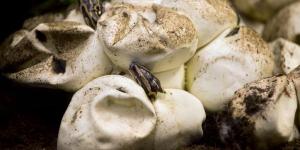How to Know When Your Dog Is Done Giving Birth



See files for Dogs
Whelping in dogs is the process of a mother dog giving birth to her puppies, also known as being in labor. It is a very sensitive time and we need to do what we can to ensure safety. Fortunately, a dog's mothering instincts are strong and she should know intrinsically what to do. Despite this, complications may still arise. A puppy could become stuck in the birthing canal, she could have a preexisting health condition or various other factors can complicate the birth. Our role should be one of observer and we should not intervene unless necessary. We should be aware of when the labor has been completed safely or when a problem needs medical assistance.
At AnimalWised, we help you know what to do during whelping by explaining how to know your dog is done giving birth. In addition to learning how to know when dog labor has finished, we look at signs of possible complications during the postpartum period in dogs.
How to know a dog has finished giving birth
If your dog has become pregnant, it is important to speak to a veterinarian to assess their health and well-being. The vet will also explain what to expect when your dog eventually starts whelping. There are various signs a dog is about to give birth, such as seeking out a nest, losing appetite, lowering body temperature and the presence of a yellowish discharge from her vulva.
Our role as guardian involves preparing a suitable nesting area and giving her peace to deliver her puppies safely. Agitation such as loud noise or manipulating her too much can cause stress. The mother should deliver her puppies one by one. The time between each puppy birth can be anywhere from 5 minutes to 2 hours. After each birth, the mother will break the amniotic sac and lick the puppy clean.
Veterinary consultation is important to assess the health of mother and puppies during pregnancy. During checkups, they should also scan the mother and count the number of puppies in utero. It is important to note this is not always exact and there is some room for error. For example we may see an ‘extra’ puppy be born because the veterinarian did not register them during imaging tests.
We will know the mother dog is finished birthing her puppies when we see the following:
- End of contractions: when there are no more puppies to be birthed, the mother will stop straining due to contractions. She should become more relaxed and her breathing should become more regulated.
- No more puppies: contractions stop because there are no more puppies in the birthing canal waiting to be born. As we have stated, it should take no more than 2 hours between each birth. It is possible it could take more time, but if the dog is still straining after 4 hours, it is likely a complication has arisen. Learn more with our article explaining how long is dog labor.
- Physical signs: due to the exertion during labor, a dog's vagina can be red and inflamed for some time after whelping has finished. Some discharge is common, something which can continue for a number of days after the puppies are born. However, this should only be a small amount and much less than during labor. Heavy bleeding should cease after contractions stop.
- Emotional signs: the mother should be calm once she has finished giving birth. She will be relieved that the physical labor is finished and will focus on caring for her newborns.
- Nursing puppies: once the dog has finished giving birth, she will shift towards mothering duties. This will involve ensuring her pups are clean, warm and fed. She will even need to lick them to stimulate defecation and urination. Dogs are altricial and will need all of their needs taken care of until they have developed sufficiently.
Learn more about the initial stages of dog development with our article asking when do puppies open their eyes fully?
Is it normal for a dog to pant after giving birth?
It is normal to observe panting in the mother dog during labor. This behavior is a response to the contractions which allow her to birth the puppies. It is also a result of the discomfort she feels during this exhausting process. She may also be restless, agitated and can even vomit due to the exertion. While this can be a sign of a complication, it can also be a normal response to the whelping process.
When labor is over, these symptoms should subside and we will see her become much more calm. The puppies will start feeding almost immediately, often requiring the mother to bring them closer to her teats. By this point, the mother should have stopped panting.
If a dog continues to pant after all of her puppies have been born, there may be a complication. This could be due to a puppy being stuck in the birth canal, stillbirth, infection or any number of possible complications during dog labor. We may also observe restlessness, nervousness, greenish vaginal discharge or other symptoms. In these cases, we need to contact a veterinarian immediately as some complications can only be treated professionally.
Eclampsia or milk fever in dogs
There is one complication of dog labor which is commonly associated with panting after giving birth. This is eclampsia, a disorder which is also known as milk fever. Eclampsia is an emergency that requires prompt veterinary assistance. It can appear up to 2-4 weeks after giving birth. In addition to panting, affected dogs may present the following symptoms:
- Lack of coordination
- Fever
- Seizures
- Walking back and forth with stiff legs
- Falling on their side
- Kicking with all four legs
- Hypersalivation
- Rapid breathing
Observation of any of these signs should prompt veterinary consultation. Eclampsia is caused by a drop in calcium levels due to poor nutrition during pregnancy, being given too many calcium supplements or a very large litter. The dog will need support to bring their calcium levels back to normal. The puppies may also need to be fed artificially until the mother recovers.
Discover more about why a dog is panting after giving birth in our related article.

Signs that a dog is not well after giving birth
Panting is not the only sign of complications after giving birth in dogs. A healthy mother will be eating, drinking, urinating and defecating as normal. After 24-48 hours, it is common for the mother to leave the nest for short periods to carry out these needs, but she will not be gone for long. She will lay down with them for most of the time in the first few days, but will start to move around a little more after this period has elapsed.
Signs of complication in dogs after giving birth can be seen with abnormal behaviors and physical signs such as the following:
- Nervousness and restlessness
- Very rapid breathing
- Sudden weight loss
- Abandonment of puppies
- Apathy
- Pale mucous membranes
- Vomiting and diarrhea
- Fever
- Painful inflammation of the breasts
- Malodorous vaginal discharge
- Persistent lochia (vaginal discharge associated with dog labor
Some of these signs are normal in context. For example, it is common for a dog to have some level of vomiting and/or diarrhea during or immediately after giving birth. Milk production will also cause breast engorgement, but it should not be very painful or show signs of infection. Some continued discharge is normal, but it should dissipate significantly after the dog has finished giving birth to her puppies. Speak to a veterinarian if you observe any of these symptoms.

What to do if a dog's labor is taking too long
When a mother dog is panting and showing signs of being in labor more than 4 hours after giving birth to her last puppy, it will mean something is wrong. In total, dog labor should take between 3-12 hours. This is the time between when contractions begin and the final puppy is born. It can take longer for some, especially if there is a large litter. The risk to the health of mother and puppies is significantly increased if labor takes more than 24 hours.
A dog's continued labor may be due to following complications:
- Puppy is stuck in birth canal
- Umbilical cord problems
- Umbilical sac won't break
- Infection
- Exacerbation of preexisting health condition
We will need to contact a veterinarian who will decide the best course of action. This will include whether we should take mother and puppies to the clinic or if it is best not to move them. It is possible the mother will need to be separated for treatment, especially if there is a possibility of infection. The puppies will need to be fed and cared for until the mother can return.
The immediate postpartum and lactation period is also a very sensitive time for mother and puppies. Newborn puppies have an undeveloped immune system and are more vulnerable to various diseases. Even if the mother is asymptomatic, it is possible she can transmit diseases which can harm the immunocompromised pups. This is another reason it is so vital to ensure regular checkups for pregnant dogs.
Some dogs may also have an emotional problem after they have given birth. This could be due to trauma, stress, poor socialization or a number of combined factors. It is even possible the dog will become aggressive after giving birth. These cases also require veterinary consultation to assess their well-being and ensure the protection of mother and puppies.
If you want to learn more about what to expect with dog labor, take a look at our guide which explains dog pregnancy week by week.
If you want to read similar articles to How to Know When Your Dog Is Done Giving Birth, we recommend you visit our Gestation category.
- Carlson and Giffin (2002). Practical manual of canine veterinary medicine . Madrid: Editorial el Drac.







